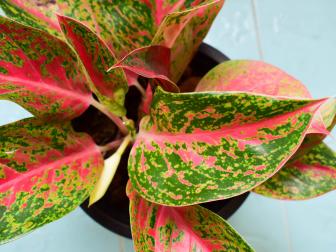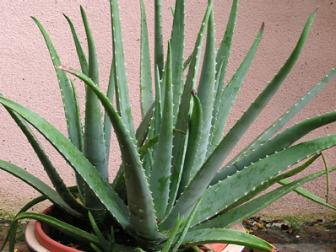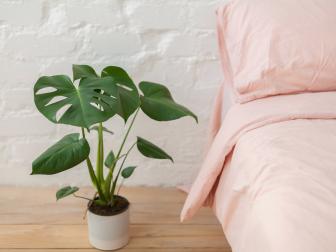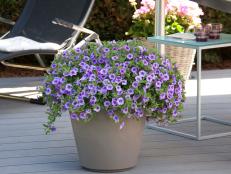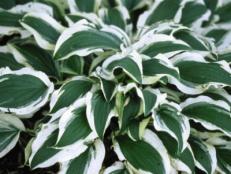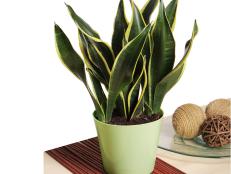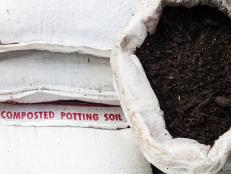How to Plant and Grow Chinese Evergreen
Caring for Chinese evergreens is easy, and these pretty houseplants brighten rooms with low light, or even no natural light, with their leaves of pink, green, creamy white and red.

Costa Farms
Chinese evergreen 'Siam Aurora' is a red Aglaonema with pointed red and green leaves.

Leafy, lovely Chinese evergreens (Aglaonema commutatum) are great choices for dim corners and other low-light spots in your home or office. Unlike many houseplants, they can tolerate periods of drought and the dry air often found indoors.
Choosing Which Chinese Evergreen to Grow
Native to tropical and subtropical Asian jungles, Chinese evergreens are grown for their beautiful leaves, which can be multi-patterned or plain in shades of green, white, red and pink. Chinese evergreen flowers that look like small peace lily flowers occasionally appear but they’re not showy. The plants typically grow to three feet tall and wide and mature slowly, so you can display them on tabletops when they’re small and later as floor plants. Caring for Chinese evergreens isn't hard, so choose the colors and leaf markings you like best.
According to a NASA study, Chinese evergreens may help remove toxins from indoor air. However, all parts of the plants contain calcium oxalate crystals, which are toxic to humans and animals if ingested. Juice from the plants can cause contact dermatitis, so keep them away from children, pets and other animals, and wear rubber gloves when handling them. Don’t get the juice in your mouth, eyes or nose.
20 Best Plants for Cleaning Indoor Air 21 Photos
Discover the top 20 air purifying plants, including Chinese evergreen.
In USDA Zones 10, 11 and 12, Chinese evergreens are perennials that can grow outside year-round. In other areas, they’re used as houseplants.
Species, Cultivars and Varieties
There are over 20 known species of Chinese evergreen plants, members of the Araceae (Arum) family, and many cultivars and varieties. Red Aglaonemas are Chinese evergreen cultivars with vibrant pink, red or green leaves. In Feng Shui, red aglaonemas are thought to bring good fortune.
Some popular Chinese evergreen varieties include:

Costa Farms
Give Aglaonema 'Pink Dalmation' a little more light — but never direct sunlight — if the spots start to fade.
‘Silver Queen’: Known for its slender, dark green leaves with silver or cream-colored stripes, ‘Silver Queen’ is also called painted drop tongue or silver queen plant.
‘Siam Aurora’: This red Aglaonema has red and lime-green leaves with red veins.
‘Edgy White’: White edges, stems and petioles brighten this Aglaonema’s dark green foliage.
‘Silver Bay’: Green margins surround this plant's silvery leaves.
‘Maria’: Also called ‘Emerald Beauty,’ Aglaonema ‘Maria’ has long, narrow leaves in light and dark green.
‘Pink Dalmatian’: This plant’s thick, leathery green leaves are highlighted with pink spots.
‘Sparkling Sarah’: Gardeners choose this pink and green aglaonema for its vibrant pink veins and stems.
How to Grow Chinese Evergreen as a Houseplant
Aglaonema houseplants prefer low to medium light levels, although those with pale variegation often need more light than others. Chinese evergreens will even tolerate bright indoor light, as long as they’re not in direct sun. Protect them with a sheer curtain if they’re near a western or south-facing exposure, or the leaves will burn. If you don’t have natural light, they’ll also grow under fluorescents.
More Houseplant Advice
21 Forgiving Houseplants 21 Photos
These are the perfect houseplants for indoor gardeners practicing their skills.
21 Indoor Plants for Low Light 31 Photos
These houseplants are perfect for homes and offices with little or no natural sunlight.
Aglaonemas are tough, dependable plants that can grow in almost any well-draining potting mix. A peat-based potting mix with lots of perlite, or three parts potting mix combined with one part perlite, are good choices.
Chinese evergreens like being slightly root-bound. When repotting, go up one pot size at a time and use a pot with drainage holes. Gently loosen any tangled roots, put the plant in the new pot, add potting mix (no deeper than the plant was in its original pot) and water.

Costa Farms
Like other Chinese evergreens, Aglaonema 'Edgy White' can grow in low to medium light with companion plants like pothos (Epipremnum aureum), ZZ plant (Zamioculcas zamiifolia) and snake plant (Sansevieria).
Getting the Planting Site Ready Outdoors
If you live in USDA Hardiness Zones 10 to 12 and want to grow your Chinese evergreen as an outdoor perennial, choose a garden spot with partial shade and no direct sun. Loosen the soil and remove any sticks, rocks and other debris. The plants can’t survive temperatures below about 50-55 degrees F.
Add Organic Matter
Add humus or other amendments, if needed, to make your garden soil moderately fertile and slightly acidic and help it drain easily.
Planting Chinese Evergreen
When Does Chinese Evergreen Grow Best?
As houseplants, Chinese evergreens do best when indoor temperatures are 65 to 80 degrees. Flowers, if they appear, open in spring or summer. Growth slows down in winter.
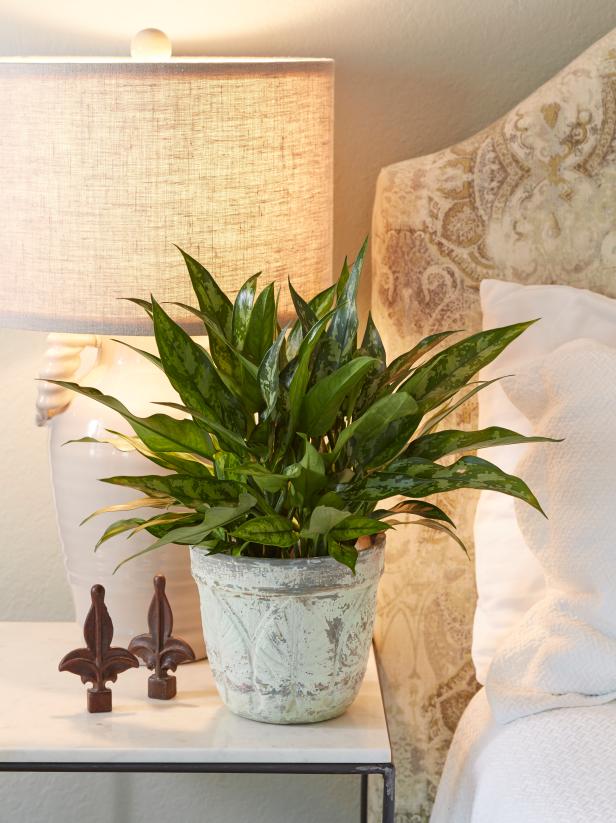
Costa Farms
Chinese Evergreen 'Emerald Beauty'
Growing and Caring for Chinese Evergreen Plants
Water Consistently
Chinese evergreen care is simple. Let the top couple of inches of soil dry out between waterings.
If you miss an occasional watering, Aglaonemas usually bounce back. They can also take dry indoor air, but they prefer high humidity. Mist to raise the humidity around them, keep your plant in a humid bathroom or kitchen, or put it on a tray or saucer filled with pebbles and a little water. Just don’t let the bottom of the pot touch the water, which can lead to root rot.
Chinese evergreens grown outdoors usually need watering more often than those grown as houseplants.
Fertilize
Feed Aglaonemas with slow-release houseplant fertilizer pellets or a water-soluble houseplant fertilizer a couple of times during the growing season. Stop fertilizing during the winter.
Scout for Health Issues
Wipe the leaves of indoor plants occasionally with a soft, damp cloth or rinse them in the shower or sink to remove any dust. Let them air dry.
Indoors or out, watch for sap-sucking pests like spider mites, scale, mealybugs and aphids. As soon as you notice spider mites, mealybugs or aphids, try knocking them off with a spray of water. Repeat if they reappear. If pests keep coming back, use insecticidal soap and follow the label directions.
Remove scale by wiping them off with a cotton ball dipped in rubbing alcohol or scraping them off with your fingernail. Rinse the leaves with water to remove the rubbing alcohol when the scale is gone.
How to Propagate Chinese Evergreen
Because Chinese evergreen seeds can take up to three months to germinate, most people divide the plants or take cuttings to propagate them.
Divide an Aglaonema when it’s actively growing. Remove it from its pot and gently separate a clump of roots. Pot the roots in fresh potting soil and water them in.
To root new plants, make six-inch stem cuttings just below a set of leaves from spring to early summer. Strip the leaves from the bottom half of the cuttings. Put them in water in indirect light. Once roots begin growing, usually after two or three weeks, transplant the cuttings into containers filled with three parts houseplant potting mix and one part perlite and keep them moist.







